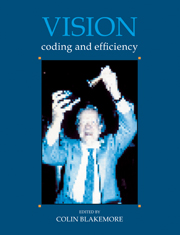Book contents
- Frontmatter
- Contents
- List of Contributors
- Preface
- Reply
- Acknowledgements
- Concepts of coding and efficiency
- Efficiency of the visual pathway
- Colour
- Brightness, adaptation and contrast
- Development of vision
- Depth and texture
- Motion
- 30 The motion pathways of the visual cortex
- 31 Interactions between motion, depth, color and form: the utilitarian theory of perception
- From image to object
- Index
30 - The motion pathways of the visual cortex
Published online by Cambridge University Press: 05 May 2010
- Frontmatter
- Contents
- List of Contributors
- Preface
- Reply
- Acknowledgements
- Concepts of coding and efficiency
- Efficiency of the visual pathway
- Colour
- Brightness, adaptation and contrast
- Development of vision
- Depth and texture
- Motion
- 30 The motion pathways of the visual cortex
- 31 Interactions between motion, depth, color and form: the utilitarian theory of perception
- From image to object
- Index
Summary
Introduction
One of Horace Barlow's major contributions to neurobiology was the discovery of directionally selective cells in the rabbit retina (Barlow & Levick, 1965) and hence of the neural mechanism for detecting one of the most fundamental and primitive of all visual stimuli, namely motion. It thus seems appropriate that my contribution to this dedicatory volume should be devoted to the same general topic of motion detection, although in the cortex, not the retina, and in the monkey, not the rabbit. My emphasis will be mainly anatomical. Although the occasion may have demanded a more physiological contribution, many of the problems raised by the anatomical facts are themselves physiological and ones in which, as I know, Horace Barlow is deeply interested and to which he continues to make contributions (Barlow, 1981). That I should have allowed myself some speculative asides in the following pages was motivated by the fact that Barlow was never concerned by exposing oneself to possible ridicule (Phillips, Zeki & Barlow, 1984) but welcomed instead informed speculations, particularly when they could be experimentally tested, as many of mine can. Some require simple experiments, others more complex ones. That even the simple ones have not been done, either by myself or others, is really due to nothing more than the exigencies of time, though in writing this article I have often wished, presumably like others, that I had the result of this experiment or that. I can only hope that the results of some of these experiments will be available in the coming years and will come to delight Barlow.
- Type
- Chapter
- Information
- VisionCoding and Efficiency, pp. 321 - 345Publisher: Cambridge University PressPrint publication year: 1991
- 11
- Cited by



